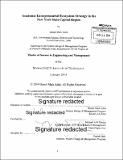| dc.contributor.advisor | Michael A M Davies. | en_US |
| dc.contributor.author | Adsit, Daniel Mark | en_US |
| dc.contributor.other | System Design and Management Program. | en_US |
| dc.coverage.spatial | n-us-ny | en_US |
| dc.date.accessioned | 2014-10-08T15:23:53Z | |
| dc.date.available | 2014-10-08T15:23:53Z | |
| dc.date.copyright | 2014 | en_US |
| dc.date.issued | 2014 | en_US |
| dc.identifier.uri | http://hdl.handle.net/1721.1/90704 | |
| dc.description | Thesis: S.M. in Engineering and Management, Massachusetts Institute of Technology, Engineering Systems Division, System Design and Management Program, 2014. | en_US |
| dc.description | Cataloged from PDF version of thesis. | en_US |
| dc.description | Includes bibliographical references (pages 117-122). | en_US |
| dc.description.abstract | The upstate New York regions are historically significant, but experienced economic decline throughout the later twentieth century. The New York State capital region, located approximately 150 miles north of New York City and west of Boston, has developed government, academic, and industrial institutions that influence economic performance and relationships. Academic theories about cluster and agglomeration development indicate that complex productivity and network dependencies significantly impact economic sustainability and resilience, while entrepreneurial activity is a critical development factor in cluster dependencies. Applied concepts from the MIT Regional Entrepreneurial Acceleration Laboratory (REAL) highlight innovative and entrepreneurial capacities linkages in the capital region, and opportunities for stakeholders to facilitate entrepreneurship. Annually, over twenty capital region academic institutions dispatch thousands of graduates into the regional, national, and global economies with skills and experiences. However, professional social network data indicates that significant fractions of regional graduates that demonstrate innovative and entrepreneurial capacities have departed in the past twenty-three years. Therefore, challenges exist to provide regional economic opportunities to these graduates. Academic entrepreneurial ecosystems present economic opportunities for regional graduates, entrepreneurial ventures, and future jobs. A system engineering analysis reveals networked accelerator potential to enhance existing academic programs, improve venture success, and reduce student entrepreneurial risk. | en_US |
| dc.description.statementofresponsibility | by Daniel Mark Adsit. | en_US |
| dc.format.extent | 122 pages | en_US |
| dc.language.iso | eng | en_US |
| dc.publisher | Massachusetts Institute of Technology | en_US |
| dc.rights | M.I.T. theses are protected by copyright. They may be viewed from this source for any purpose, but reproduction or distribution in any format is prohibited without written permission. See provided URL for inquiries about permission. | en_US |
| dc.rights.uri | http://dspace.mit.edu/handle/1721.1/7582 | en_US |
| dc.subject | Engineering Systems Division. | en_US |
| dc.subject | System Design and Management Program. | en_US |
| dc.title | Academic entrepreneurial ecosystem strategy in the New York state capital region | en_US |
| dc.type | Thesis | en_US |
| dc.description.degree | S.M. in Engineering and Management | en_US |
| dc.contributor.department | System Design and Management Program. | en_US |
| dc.contributor.department | Massachusetts Institute of Technology. Engineering Systems Division | |
| dc.identifier.oclc | 891062684 | en_US |
